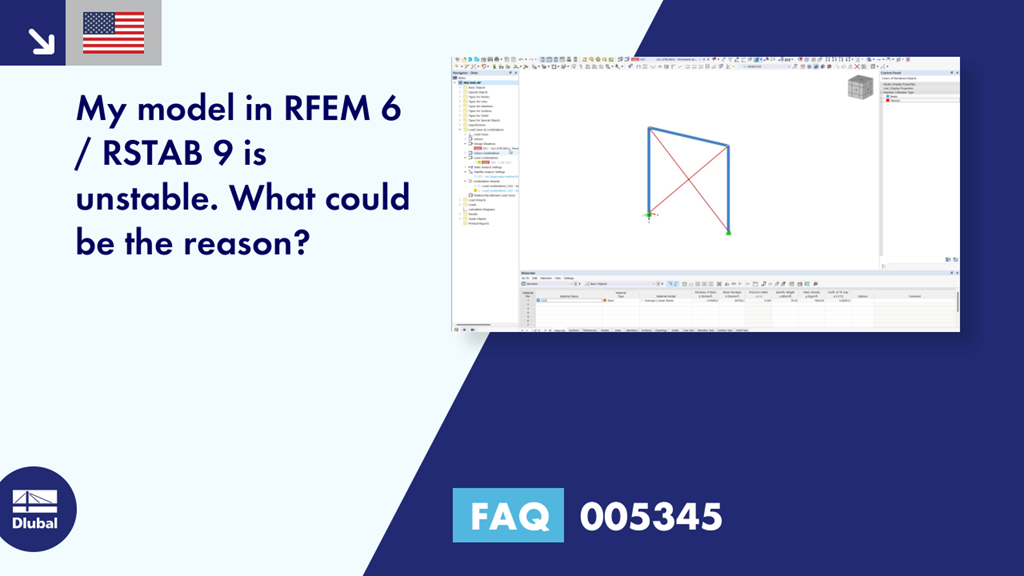Question:
My model in RFEM 6 / RSTAB 9 is unstable. What could be the reason?
Answer:
A calculation break‑off due to an unstable system can have different reasons. On one hand, it can indicate a "real" instability due to overloading the structural system; on the other hand, modeling inaccuracies may also be responsible for this error message. Here, we have compiled a possible procedure for finding the cause of the instability.
1st Modeling Check
First, check whether the modeling system is OK. We recommend using the model check tools provided by RFEM 6 / RSTAB 9 (Tools → Model Check). These options allow you to find identical nodes and overlapping members, for example, so you can delete them, if necessary.
Furthermore, you can calculate the structure subjected to pure dead load in a load case according to the linear static analysis, for example. If results are displayed subsequently, the structure regarding the modeling is stable. If this is not the case, you can find the most common causes in the following list:
• Incorrect Definition of Supports / Lack of Supports
This can lead to instabilities, as the structure is not supported in all directions. Therefore, make sure that the support conditions are in equilibrium with the structural system as well as with the external boundary conditions. Statically underdetermined systems can also lead to calculation aborts due to a lack of boundary conditions.
• Torsion of Members About Their Own Axes
If members rotate about their own axes—that is, a member is not supported about its own axis—this can lead to instabilities. This is often caused by the settings of member hinges. Thus, it may happen that the torsional releases are entered at both the start node and the end node.
• Missing Connection of Members
Do you find free members? Especially in the case of large and complex models, it may quickly happen that some members are not connected to each other, thus they "float in the air." Also, if you forget about crossing members that should intersect with each other, this may lead to instabilities as well. One remedy is the model check of "Crossing Unconnected Members", which searches for members that cross each other, but do not have a common node at the intersection point.
• No Common Node
Look closely. Here, the nodes are apparently at the same location, but on closer inspection, they deviate slightly from each other. This is often caused by CAD imports, but you can correct it using the model check.
• Formation of Hinge Chain
Pay attention to member hinges: Too many of them on a node can cause a hinge chain that leads to a calculation abort. For each node, only n‑1 hinges with the same degree of freedom relative to the global coordinate system may be defined, where "n" is the number of connected members. The same applies to line releases.
2nd Check of Stiffening
If the stiffening is missing, it may also lead to calculation aborts due to instabilities. Therefore, you should always check whether the structure is stiffened sufficiently in all directions.
3. Numerical Problems
To this point, we show you the following example. It is a hinged frame that is stiffened by tension members. Due to the shortening of the posts as a result of the vertical loads, the tension members receive small compressive forces in the first calculation run. They are removed from the structure (since only tension can be absorbed). In the second calculation step, the model is unstable without these tension members. To solve this problem, you have several options. You can apply a prestress (member load) to the tension members in order to "eliminate" the small compressive forces, assign small stiffness to the members, or remove the members one by one in the calculation.
The calculation setting is automated in RSTAB 9, and this can be optionally activated in RFEM 6.
4. Detecting Causes of Instability
• Automatic Model Check with Graphical Result Display
To obtain the graphical display of the instability cause, the Structure Stability add-on for RFEM 6 / RSTAB 9 can help you.
Select the "Calculate without loading for instability check by mode shape…" to calculate the unstable structure. An eigenvalue analysis is carried out on the basis of the structural data; it graphically displays the instability of the affected structural component as a result.
• Critical Load Problem
If load cases or load combinations can be calculated according to the linear static analysis...








